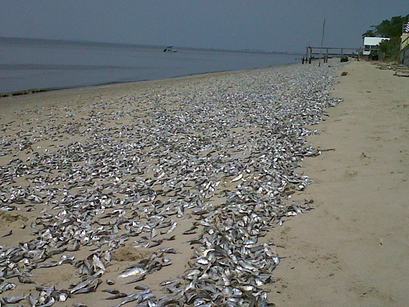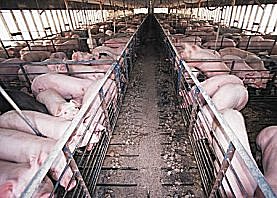The expression, “like a canary in a coal mine” was used to describe the alarm system for coal miners in the late 19th and early 20th century. The small birds were brought down into the mines to be a zoological early warning to alert miners of toxic gases or fumes. The canaries would choke and die earlier than people so the men knew they should take action!
Explanations of large scale bird and fish deaths over the past 7 days are as follows: hail, lightening, heavy winds fireworks, disease, tornado, upper atmospheric disturbance, mass confusion, hit by something, bird government experiments, power lines, extreme temperatures (hot or cold), massive trauma, struck by a car or my personal favorite, the 2nd coming of Christ. I think we should add chemicals to the list ~ Don’t you? The experts may be overlooking several chemicals because they do not consider these chemicals to be deadly. Why? Because the same chemicals are found in 90% of every man, woman and child in the USA. One more thing, pollution and poison HAS been ruled out. I believe that ruling out “pollution” is unwarranted and too early.
New Years Eve ~ between 3,000-5,000 dead red-winged black birds in Ozark, AR fell to earth. The very next day, 125 miles away, 80,000-100,000 drum fish died on a 20 mile stretch of the Arkansas River.
http://www.cbsnews.com/stories/2011/01/03/national/main7208349.shtml
or
http://www.msnbc.msn.com/id/40887450/ns/us_news-environment/
I called the Army Core of Engineers (ACE) in Arkansas to find out if Beebe was downstream of Ozark – NO – Little Rock is downstream. I asked if something like a chemical could have been spread by air carrying the winds southeast to Beebe and landing in the streams. ACE stated, “It is unlikely because the fish are bottom feeders…it may be a disease. The birds dying at the same time is just a coincidence.”
The fish died on a 20 mile stretch on the Arkansas River near Ozark, AR and the 3-5,000 birds died just 125 miles south-east of Ozark in Beebe, AR. Two days later, 300 miles due south, 500 red winged black birds die in Louisiana. Coincidence…but the deaths keep coming!
Jan. 4, 2011 ~ Now if that were not enough fowlness, Louisiana’s sky drops 500 blackbirds and starlings. http://www.cbsnews.com/stories/2011/01/04/national/main7212053.shtml
Jan. 4. Mullet Ladyfish, Catfish found dead in the thousands; Port Orange, FL said to be largest fish kill seen there.
http://www.wftv.com/video/26368602/index.html
Jan 5, 2011 ~ Two million fish wash up on shore and is considered the biggest fish kill in Chesapeake Bay, MD since 1980.
http://news.sky.com/skynews/Home/World-News/Two-Million-Fish-Found-Dead-In-Chesapeake-Bay-Maryland-After-Birds-Die-In-Arkansas-And-Louisiana/Article/201101115880847?f=rss
Jan 7, 2010 ~Around 10,000 menhaden fish were found dead on the shores of Folly Beach, NC. http://www.ktsm.com/news/more-fish-bird-deaths-this-time-world-wide
Jan. 7, 2011 ~Western Kentucky, hundreds of grackles, robins, starlings and blackbirds die mysteriously. http://www.huffingtonpost.com/2011/01/05/hundreds-more-dead-birds-_n_804952.html
Articles all over the world have been discussing their own wildlife deaths: Vietnam, Sweden, Brazil, Italy and New Zealand Brittan, have also had large fish/bird deaths in the past week. But we will stay focused on the good ‘ol USA.
The aflockalypse? Well, the scientific community does not believe in the unconventional scare tactics and neither does Save Maumee. However this should be a warning to all. Mass deaths of animals have always happened. Most of these deaths have happened to large populations and have been getting lots of attention – but slower mass extinction of thousands of species because of human activity is going ignored. Remember, population in nature takes care of itself, (i.e. natural selection & survival of the fittest) but this law of nature goes for the human race as well.
This all seems reminiscent of a book written by Rachel Carson called Silent Spring~ Please Read IT. Aldrin, Dieldrin, Heptachlor and DDT or the overall term “chlorinated hydrocarbons” and a second group of insecticides, “organic phosphates” are among the most poisonous chemicals in the world. They wreaked havoc on the natural environment in the 40’s and 50’s. As early as 1950 the FDA declared “it is “extremely likely the potential hazard of DDT has been underestimated” http://www.pan-uk.org/pestnews/Actives/ddt.htm By the way, ALL these chemicals were spread indiscriminately across the landscape of the USA for years before the disastrous effects were discovered.
What types of things do these chemical concoctions produce? mutagens, agents capable of modifying genes (the material for heredity) paralysis, internal bleeding, instantaneous death, widespread cancer…and many more side effects
http://www.pan-uk.org/pestnews/Actives/ddt.htmThese chemicals can travel in groundwater, surface water, up tubules of plants that we eat, reside on fruit and remains in soil.
Connect the dots together for yourself and take action lovely people of Earth. I know that our planet is does not start with a capital letter, but from now it should be.
*duly noted, the numbers of fish and bird deaths are range estimates from different stories referenced, but the several locations are concerning.



